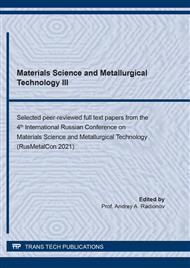[1]
P. Cavaliere, Fatigue and Fracture of Nanostructured Materials, Springer, (2021).
Google Scholar
[2]
C.C. Koch, Nanostructured Materials: Processing, Properties and Applications, Elsevier Science, (2006).
Google Scholar
[3]
G. Abrosimova, A. Aronin, Amorphous and nanocrystalline metallic alloys, Progress in Metallic Alloys. (2016) 45-83.
DOI: 10.5772/64499
Google Scholar
[4]
V.N. Shinkin, Springback coefficient of round steel beam under elastoplastic torsion, CIS Iron and Steel Review. 15 (2018) 23-27.
DOI: 10.17580/cisisr.2018.01.05
Google Scholar
[5]
V.N. Shinkin, Simple analytical dependence of elastic modulus on high temperatures for some steels and alloys, CIS Iron and Steel Review. 15 (2018) 32-38.
DOI: 10.17580/cisisr.2018.01.07
Google Scholar
[6]
N.V. Priezjev, The effect of thermal history on the atomic structure and mechanical properties of amorphous alloys, Computational Materials Science. 174 (2020) 109477.
DOI: 10.1016/j.commatsci.2019.109477
Google Scholar
[7]
V.N. Shinkin, Preliminary straightening of steel strip, Chernye Metally. 5 (2018) 34-40.
Google Scholar
[8]
V.N. Shinkin, Direct and inverse non-linear approximation of hardening zone of steel, Chernye Metally. 3 (2019) 32-37.
Google Scholar
[9]
I.V. Ushakov, V.A. Feodorov, I.J. Permyakova, Mechanical characteristics and crystallization of annealed metallic glass 82K3XCP, Proceedings of SPIE – The International Society for Optical Engineering. 5400 (2004) 261-264.
DOI: 10.1117/12.555528
Google Scholar
[10]
V.N. Shinkin, Elastoplastic flexure of round steel beams. 1. Springback coefficient, Steel in Translation. 48(3) (2018) 149-153.
DOI: 10.3103/s0967091218030117
Google Scholar
[11]
V.N. Shinkin, Elastoplastic flexure of round steel beams. 2. Residual stress, Steel in Translation. 48(11) (2018) 718-723.
DOI: 10.3103/s0967091218110098
Google Scholar
[12]
H. Gleiter, Nanocrystalline materials, Progress in Materials Science. 33 (1989) 223-315.
Google Scholar
[13]
I. Pestriak, V. Morozov, E. Otchir, Modelling and development of recycled water conditioning of copper-molybdenum ores processing, International Journal of Mining Science and Technology. 29(2) (2019) 313-317.
DOI: 10.1016/j.ijmst.2018.11.028
Google Scholar
[14]
I.V. Pestryak, Modeling and analysis of physicochemical processes in recirculating water conditioning, Journal of Mining Science. 51(4) (2015) 811-818.
DOI: 10.1134/s1062739115040189
Google Scholar
[15]
I.V. Pestryak, O. Erdenetuyaa, V.V. Morozov, Return water improvement at erdenet mining complex, Obogashchenie Rud. 2 (2013) 3-8.
Google Scholar
[16]
I. Loginova, A. Khalil, A. Pozdniakov, A. Solonin, V. Zolotorevskiy, Effect of pulse laser welding parameters and filler metal on microstructure and mechanical properties of Al-4.7Mg-0.32Mn-0.21Sc-0.1Zr alloy, Metals. 7(12) (2017) 564.
DOI: 10.3390/met7120564
Google Scholar
[17]
I.V. Ushakov, Yu.V. Simonov, Formation of surface properties of VT18u titanium alloy by laser pulse treatment, Materials Today: Proceedings. 19(5) (2019) 2051-2055.
DOI: 10.1016/j.matpr.2019.07.072
Google Scholar
[18]
I. Safronov, A. Ushakov, Effect of simultaneous improvement of plasticity and microhardness of an amorphous-nanocrystalline material based on Co, as a result of laser processing of nanosecond duration, Materials Today: Proceedings. 38(4) (2021) 1516-1520.
DOI: 10.1016/j.matpr.2020.08.141
Google Scholar
[19]
J. Bonse, et al., Femtosecond laser-induced periodic surface structures on steel and titanium alloy for tribological applications, Applied Physics A: Materials Science and Processing. 117 (2014) 103-110.
DOI: 10.1007/s00339-014-8229-2
Google Scholar
[20]
I.V. Ushakov, Method of mechanical testing of laser treated metallic glass by indenters with different geometry, Proceedings of SPIE - The International Society for Optical Engineering. 6597 (2007) 181-185.
DOI: 10.1117/12.726773
Google Scholar
[21]
Z. Jia, P. Zhang, Z. Yu, et al., Effect of pulse shaping on solidification process and crack in 5083 aluminum alloy by pulsed laser welding, Optics and Laser Technology. 134 (2020) 106608.
DOI: 10.1016/j.optlastec.2020.106608
Google Scholar
[22]
I.V. Ushakov, How a crack and the defect material in its neighborhood affect the radiation strength of transparent materials, Journal of Optical Technology. 75(2) (2008) 128-131.
DOI: 10.1364/jot.75.000128
Google Scholar
[23]
K. Tserpesa, P. Baziosa, S. Pantelakisa, N. Michailidisb, Nanoindentation testing and simulation of nanocrystalline materials, Procedia Structural Integrity. 28 (2020) 1644-1649.
DOI: 10.1016/j.prostr.2020.10.136
Google Scholar
[24]
I. Peshko, Laser Pulses: Theory, Technology and Applications, InTech, (2016).
Google Scholar
[25]
M. Philbert, M. Billard, G. Fertin, J. Lefevre, Thermal blooming of high power laser beams, Journal de Physique Colloques. 41(9) (1980) 149-154.
DOI: 10.1051/jphyscol:1980920
Google Scholar
[26]
Kh. Bazzal, V.V. Lychkovskii , A.P. Zajogin , Processes of forming of aluminum nitride in plasma by action of defocused doble laser beams upon aluminum in air atmosphere, Journal of the Belarusian State University: Physics. 3 (2018) 81- 90.
Google Scholar
[27]
T. Wang, J. Pu, Z. Chen, Beam-spreading and topological charge of vortex beams propagating in a turbulent atmosphere, Optics Communications. 282(7) (2009) 1255-1259.
DOI: 10.1016/j.optcom.2008.12.027
Google Scholar
[28]
V.I. Emel¢yanov, I.F. Uvarova, Nonlinear-optical deformation of an acoustic subsystem and the superfast smoothing of semiconductor surfaces by short laser pulses, Bulletin of the Academy of Sciences of the U.S.S.R. Physical Series. 50(6) (1985) 164-169.
Google Scholar
[29]
V.I. Emel¢yanov, V.S. Makin, I.F. Uvarova, Formation of ordered vacancy-deformation structures on metal surface under laser irradiation, Physics and Chemistry of Materials Treatment. 24(2) (1990) 108-114.
Google Scholar
[30]
V.S. Burakov, N.V. Tarasenko, N.A. Savastenko, Plasma chemistry in laser ablation processes, Spectrochimica Acta Part B. 56 (2001) 961-971.
DOI: 10.1016/s0584-8547(01)00192-6
Google Scholar


